Fairground Photographs
"Roller Coaster Photos"Original Article by Steve Hynes
"Article first featured in Olympus User Magazine"
A BUSTLING ATMOSPHERE can provide rich pickings for terrific fairground photographs. With lots of action and colour, there are numerous opportunities to put your skills to the test. Opportunities range from pictures of terrified patrons to bold and colourful images of the whirling rides. And just when you think you’ve exhausted all the possibilities, twilight falls and transforms the entire scene, providing a whole new set of image opportunities.
My first tip is to pick a nice sunny day with bright blue skies. The brilliant colours just don’t look as appealing against a washed out sky. Also, time your visit to include twilight as this is when many of the most interesting fairground photographs can be created. Take a tripod, as you will need it for the twilight shots.
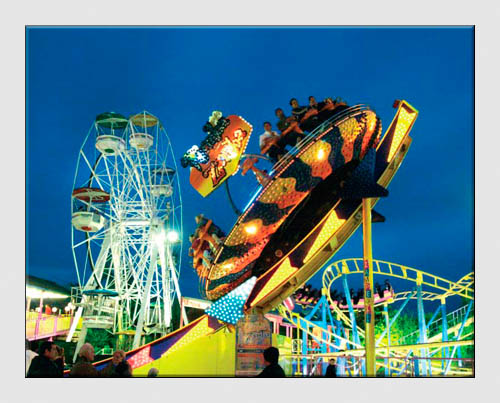
Capturing these images will test your reflexes and ability to anticipate the action. Whether you’re trying to freeze the action or use controlled blur to convey a sense of speed, it’s your skill that really makes the difference.
There is one further point to keep in mind. In these days of widespread misuse of images on the internet, many people don’t like having their pictures, or pictures of their children, taken by a stranger. If you wander around a fairground alone with a camera you will soon be pounced on by security.
They’re not trying to give you a hard time, but merely protecting the interests and wishes of their patrons. The best approach is to go along with a group of friends or family. Once they see that you are taking fairground photographs of people in your group they will leave you alone and other patrons are unlikely to be concerned.
1The twilight zone
Dusk brings the fairground to life with thousands of lights. But you have to work quickly, as there is a window of only about 20 minutes when the sky still has enough light to render as a deep indigo, providing a pleasing background for the fairground lights.
Once the sky goes black the contrast becomes too great to make well balanced fairground photographs. This ride made a pleasing shot when photographed at a slow shutter speed, allowing the riders to become a complete blur, but freezing the motion with a higher shutter speed also worked.
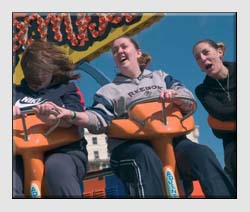
2Action reaction
Capturing the expressions of people on a ride requires good anticipation and reactions. Firstly, you should watch the ride a couple of times to work out where you need to aim. There is usually one point on a ride at which people react, while at other points they can look rather expressionless. Also, consider your angle when choosing a vantage point – shooting from below adds to the action.
Once you’ve worked out where the action happens, you need to manually pre-focus on that point and wait for the riders to come into frame. Prefocusing is better than autofocus in these situations, as even the best autofocus systems would struggle to track such fast movement so close to the camera. A fast shutter speed is needed to freeze the action. This shot was taken at 1/1000 second using shutter priority mode.
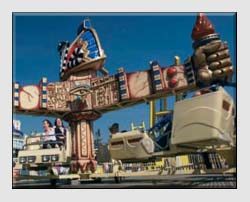 3Get down low
3Get down low
Rides are usually colourful and bold in form, but shooting them from a normal height can result in fairground photographs with a cluttered background of equally dynamic machines. To capture the essence of this ride, a low shooting angle was chosen, shooting through the safety fence with a wide angle lens.
A fast shutter speed was selected to preserve the overall sharpness, but a slow speed that allowed some blurring at the ends of the arms would also work well. Rides are not always full, so try to shoot when there are occupied carriages in shot. Although the two girls are a minor element in this shot, they are important to the overall composition.
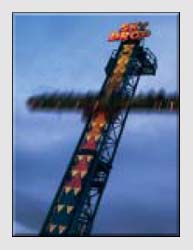
4Sky drop
The ‘sky drop’ ride may be exciting to ride on but it makes a rather static image when photographed conventionally. Twilight provided a more interesting possibility.
With its lights on and a deep blue sky behind, and the camera on a tripod, a slow shutter speed was selected to show the movement of the platform. Angling the upright column across the diagonal of the frame also gives fairground photographs more impact.
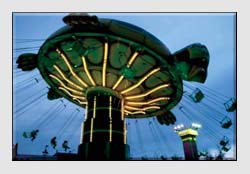 5Freeze!
5Freeze!
Freezing the action of fast-moving rides at night requires the use of high ISO settings. For this image a setting of ISO 800 was used, with the lens wide open to allow a shutter speed of 1/125 second. The penalty for using high ISO ratings is an increase in the image ‘noise’, giving a grainy appearance, particularly noticeable in areas of even tone such as the sky.
Nevertheless, some pleasingly vibrant fairground photographs can be captured in this way. Once again, the window of opportunity for this type of shot is quite narrow, lasting only as long as there is some light in the sky.
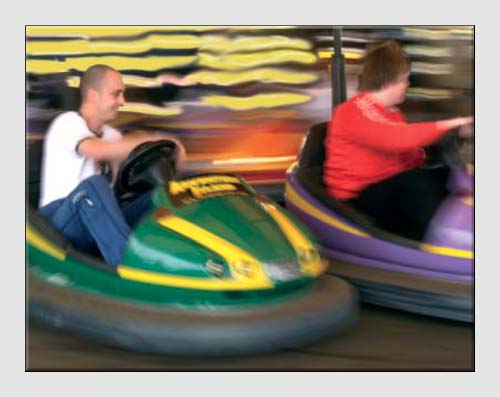
6Dodgems
Let’s face it – dodgem cars are hardly the high point of fast action. However, some interesting images can be made by using controlled blur to produce a sense of speed. A slow shutter speed of around 1/4 second is a good starting point. Images that are blurred all over are very easy to capture, but it’s a little harder to get a picture in which a key point, such as the driver’s face, is relatively sharp while the rest of the image is more blurred.
To do this you need to pan so that the driver’s face remains at the same point in the frame throughout the exposure. It does take some practice and results are always going to be rather hit-and-miss.
© Olympus UK
Click here for more Tutorial Articles by OM Systems
(formerly Olympus Cameras).
Return from Fairground Photographs to the Photography Tutor page.

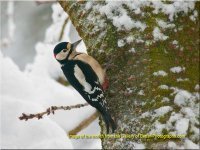

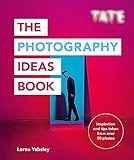


 3Get down low
3Get down low

 5Freeze!
5Freeze!


New! Comments
Have your say about what you just read! Leave me a comment in the box below.